- Joined
- Feb 2, 2013
- Messages
- 3,962
Hi Again,
I'm not a good woodworker,
but i'm trying to improve my skills as well as show my son how to work with his hands.
I learned skills in my youth without knowing it, by being around good men that worked with their hands and minds.
I want the very same thing for my son, to know the sweet taste of accomplishment obtained nowhere else than from your own hand, to know he can be a master of anything he wishes-
if he's willing to work at it.
After a short search on CL, i found a new victim!
I got a decent price on a barely used, but non-functioning Craftsman Planer/Jointer that will help in the pursuit of the study of woodworking.

a picture post scraping, #metalscraping
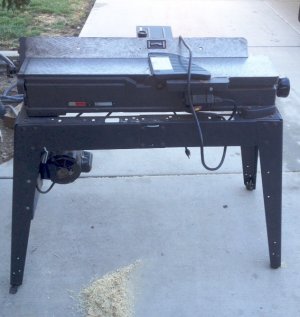
the GFIC outlet in my garage shop kept tripping and wouldn't allow start up of the motor.
I had another 1/2 hp 56 cradle frame motor that was a match except for the RPM.
the motor i have, had a 1740 nominal RPM, the factory motor is 3450 RPM.
to compensate for the slower motor, i increased the motor drive pulley to double it's size (from stock) to keep the same approximate cutter speed. The replacement was quite simple and i just happened to have a pulley that was exactly the size i needed too! (that NEVER happens )
)
i was able to use the same drive belt. Luckily the motor mounting is very forgiving and was easily done.
as you can see by the chips , it works!!!!!
You can see below that i couldn't leave the cast iron unscraped...
it had a very rough machining that i just could not let go...
i took out the biax and scraped the deck and fence to remove the light layer of oxidation.
the cast iron scraped well.
i may just end up scraping it for accuracy later on, for now i'm just too impatient- i wanna play with it
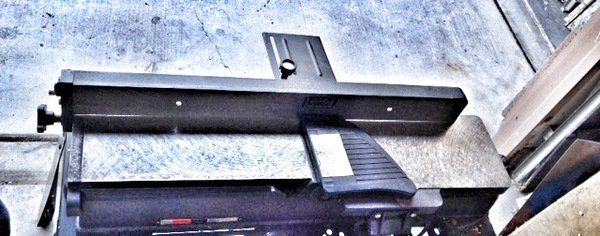
here's a rear view,
notice the fence adjustment in the center of the picture,it's a piece of light gauge sheetmetal and a plastic knob, that i found it a bit too light duty.
i may need to construct something more substantial in another project.
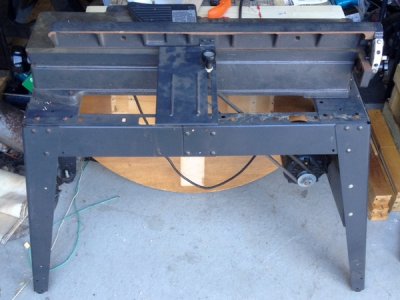
the original motor and pulley are pictured in this picture.
the stand was part of the original package denoted by the 113.206932 model #.
thanks for reading, i always welcome questions and comments!
if you have woodworking tips in pertinence to jointing and planing, i'd love to hear them.


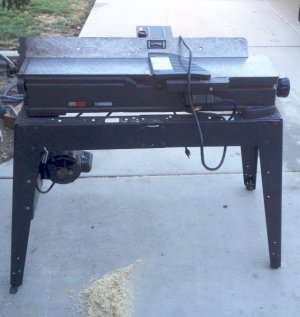
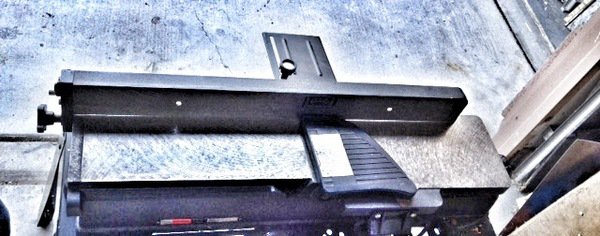
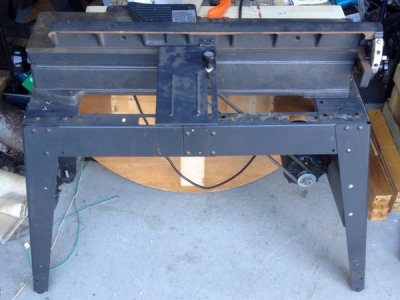
I'm not a good woodworker,
but i'm trying to improve my skills as well as show my son how to work with his hands.
I learned skills in my youth without knowing it, by being around good men that worked with their hands and minds.
I want the very same thing for my son, to know the sweet taste of accomplishment obtained nowhere else than from your own hand, to know he can be a master of anything he wishes-
if he's willing to work at it.
After a short search on CL, i found a new victim!
I got a decent price on a barely used, but non-functioning Craftsman Planer/Jointer that will help in the pursuit of the study of woodworking.

a picture post scraping, #metalscraping

the GFIC outlet in my garage shop kept tripping and wouldn't allow start up of the motor.
I had another 1/2 hp 56 cradle frame motor that was a match except for the RPM.
the motor i have, had a 1740 nominal RPM, the factory motor is 3450 RPM.
to compensate for the slower motor, i increased the motor drive pulley to double it's size (from stock) to keep the same approximate cutter speed. The replacement was quite simple and i just happened to have a pulley that was exactly the size i needed too! (that NEVER happens
i was able to use the same drive belt. Luckily the motor mounting is very forgiving and was easily done.
as you can see by the chips , it works!!!!!
You can see below that i couldn't leave the cast iron unscraped...
it had a very rough machining that i just could not let go...
i took out the biax and scraped the deck and fence to remove the light layer of oxidation.
the cast iron scraped well.
i may just end up scraping it for accuracy later on, for now i'm just too impatient- i wanna play with it

here's a rear view,
notice the fence adjustment in the center of the picture,it's a piece of light gauge sheetmetal and a plastic knob, that i found it a bit too light duty.
i may need to construct something more substantial in another project.

the original motor and pulley are pictured in this picture.
the stand was part of the original package denoted by the 113.206932 model #.
thanks for reading, i always welcome questions and comments!
if you have woodworking tips in pertinence to jointing and planing, i'd love to hear them.





